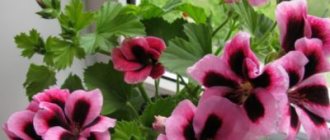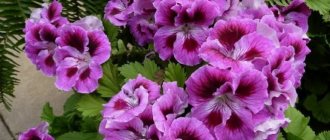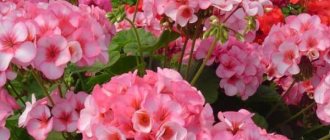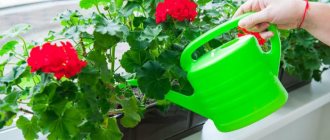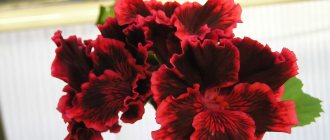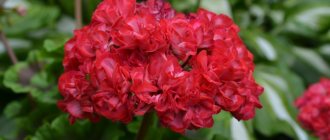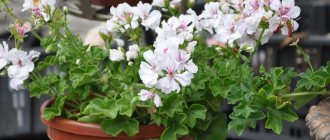Pelargonium is a favorite of flower growers all over the world.
Noble, homely, royal - it is no coincidence that royal geranium or pelargonium has earned such epithets from flower growers. Among the many types of geranium, it stands out for its unusual curly flowers, reminiscent of pansies. It is for this curly miracle, despite the capricious nature of the plant, that it is valued, loved, and popular.
Pelargonium is very popular as a decoration for terraces of houses on the coasts.
Royal geranium with burgundy buds looks great
Pelargonium will help decorate your landscape design
Kinds
Brought to Europe at the end of the 18th century, domestic pelargonium was subjected to active selection, revealing to the world a huge number of hybrids. Among them there are those that grew in almost every home in Soviet times, and new varieties of pelargonium that have gained popularity today.
- Pelargonium zonalis or popularly “kalach” is the most common type of plant, the tall, erect bushes of which still decorate our balconies today. The flower received the prefix “zonal” for its peculiarly colored leaves, on which dark and light circles intricately alternate. In decorative terms, varieties such as “Jacqueline”, “Golden Crest” and “Stella” are interesting.
- Ivy-leaved pelargonium attracts gardeners with its flexible, creeping stems, with the help of which amazing cascading compositions are created. Its leaves are not even pubescent, like many geraniums, but fleshy and dense, like ivy. Designers use ampelous pelargonium to decorate terraces and gazebos.
- Pelargonium angel is a miniature copy of the royal pelargonium, with small flowers similar in shape to those of the royal species. It is interesting for its ability to metamorphose: in the shade the “angel” produces an ampelous cascade, and in the sun it turns into a zonal upright bush.
Beautiful pelargonium angel with its variegated flowers
- Pelargonium rosebud is valued by flower growers for its pink inflorescences. Numerous terry petals fit so tightly to each other that they do not have time to open and look like rose buds.
One of the varieties of rosebud pelargonium (Rosebud)
Bright, long-blooming, fragrant pelargonium is magnificent both in landscape design and in the home garden on the balcony. However, in order to admire the lush flowering of geraniums, it is important to provide the plant with proper care.
Preparation of planting material and propagation
Royal pelargonium (the varieties in the photo will tell you how to properly prepare and propagate planting material) is propagated by cuttings and seeds. A common method is cuttings, since after the bush develops, cuttings are formed in large quantities.
Seed reproduction is considered a more difficult and lengthy process of reproduction. It will not be possible to obtain seed material on your own, since all representatives of the crop are hybrids. Their seeds are not able to retain the properties of the mother plant. It is recommended to take seeds from specialized stores, as the flowers will be healthy and strong.
Seeds
Breeding royal pelargonium from seeds can be carried out according to the following points:
- The seeds need to be distributed over a loose soil layer together with sand or perlite in an amount of half the total mass. The substrate will need to be treated with a manganese solution.
- The seeds need to be covered with moistened sand and then deepened a little. The entire container must be covered with film or glass, placed in a bright place without direct rays and at a temperature of up to +25 ℃.
- After the development of true leaves, the sprouts must be distributed into separate pots with a diameter of 10 cm and a depth of up to 14 cm with holes and drainage based on expanded clay.
- When the 5th true leaf appears, the seedlings must be pinched. This will stimulate branching and allow you to grow a more lush bush.
Cuttings
A young plant can be obtained using the cutting method in a fairly short period of time. At home, the method is available all year round. Survival rate largely depends on the time of year and type of crop. For pelargonium to form roots, it takes up to 4 weeks in summer, and up to 56 days in winter. Cuttings obtained during spring pruning have a high survival rate. Specimens grown in the fall will weaken and stretch over the winter, so it is necessary to provide lighting for them and pinch them in the spring.
Cuttings that were grown in the fall will begin to bloom in a year, not earlier than June. There will be abundant flowering if the material is prepared in April or March. In order for the cutting to adapt and grow, it must be 5 cm long, have about 3 leaves and 3 internodes with the leaves removed at the bottom. If the preparations were obtained during summer flowering, the inflorescences will need to be removed. The presence of flowers with buds can slow down root formation and weaken the crop.
Royal pelargonium can be propagated by cuttings using the following steps:
- The required length of the stem must be cut with a sterile sharp knife. You can use the blade by keeping it in boiling water for about 5 minutes. or treated with alcohol. The cut area will need to be treated with activated carbon.
- Then the cuttings should be left to dry. You can put it in a container with water diluted with an activated carbon tablet. To securely fix pelargonium, place a piece of cardboard on the container with holes through which the flower stems pass.
- The cutting should be immersed in liquid no more than 1/3. However, this method can cause rotting, so they are immediately placed in separate pots. For these purposes, it is permissible to use plastic cups with holes in the base.
- There should be drainage at the bottom, the soil layer should consist of vermiculite or sand. The soil mixture should be disinfected with boiling water or manganese solution, and then allowed to cool and settle for 24 hours.
- Before planting, you will need to dip the cuttings in Kornevin.
- Then the culture needs to be buried 2 cm into the soil cover and placed in a room with low light, leaving for 5 days. The absence of bright light will allow the plant to form a root system in a short period of time.
- Afterwards, the pelargonium should be placed on the window, watering through a tray so that the stems do not begin to rot. The optimal temperature is considered to be from +14 to +16 ℃.
The seedlings may not cope and turn yellow. To do this, the specimens need to make a greenhouse by covering them with a jar. The appearance of new leaves is considered a good sign that the seedling has taken root.
Pelargonium care
Growing royal pelargonium at home is a notoriously difficult process. The geranium aristocrat is capricious and demanding.
Plants are partners
The best flowers - partners for royal lilies:
- Echinops;
- ornamental cereals;
- geranium and peony;
- sage, buzulnik and echinacea;
- tulips, crocuses and daffodils;
- delphiniums.
Ideal neighbors for lilies are peonies and phlox. Compositions with such colors look best.
When planting in a rock garden, it is necessary to take into account the neighboring plantings - they should not be higher than the lilies, so as not to block them from light
Temperature
The proud beauty does not particularly favor high air temperatures; for her, comfortable values are +20-25 degrees in summer and 15-17 degrees in winter. She will feel uncomfortable on the south window, but she will like the north or east side.
Experts believe that to set the buds of royal geranium, a winter temperature of +12-15 degrees is needed.
Important! The royal pelargonium flower does not tolerate drafts, is afraid of direct sunlight and suffers from dry air. Make sure that in the place where you place the plant, all these negative factors are absent.
A very traditional and at the same time very romantic look: wrought iron furniture for an impromptu corner for two in a garden with pelargoniums
Royal geranium will fit perfectly into a country-style exterior
Delphinium
Prince Charles's favorite flower is the delphinium. This spectacular flower has been grown in the UK for centuries. The dark blue delphinium represents royal wealth and power.
More than just turning off the lights: how you can support the Earth Hour project
They will decorate the yard and produce a harvest: the best ideas for above-ground beds
Octopus ancestors may be 30 million years older, fossils suggest
For best results, plant the delphinium in a sunny location in well-drained soil. Don't forget that delphiniums produce rather tall flower shoots, so make sure they are protected from the wind. Otherwise, delphiniums are unpretentious, they can be planted at any time of the year (except winter), but it is best in spring or autumn, since at this time the soil is warm and moist.
Watering
The watering scheme for royal pelargonium is usual: in summer regularly, but moderately, in winter rarely and in small portions. But there are some nuances here too:
- use soft, rain or settled water for irrigation
- Do not water the pot, pour water into the pan. Plants react poorly to soil compaction and may get sick
Myrtle
Since the reign of Queen Victoria, all royal brides have used sprigs of myrtle in their royal bouquets. This plant adorned the wedding bouquets of Queen Elizabeth II and Kate Middleton. Surprisingly, all the myrtle sprigs at royal weddings come from the same bush, growing in Osborne. This myrtle was given to Queen Victoria by Prince Albert's grandmother.
The best time to plant myrtle is early spring or late autumn. This plant is not very demanding to care for and will be a great decoration for your garden. You can grow myrtle in your garden as a free-standing plant or use several bushes at once as a border or hedge.
Transfer
Justifying its harmful nature, grandiflora pelargonium does not like frequent replanting. If you plan to keep royal pelargonium in open ground in the summer, then be prepared for the fact that moving it to wintering may cause the death of the plant.
Pelargonium in flowerbeds integrated into the exotic landscape of a barbecue corner
Grandiflora pelargonium (Pelargonium grandiflorum) is less common than its close relative, zonal pelargonium.
Attention! When providing royal geranium care at home, when replanting, limit yourself to adding substrate to the pot, but do not rush to replant the flower. Pelargonium disturbed at the wrong time will take offense and stop blooming.
The plant is calm about the composition of the soil, and happily grows in a mixture of humus, turf and leaf soil, sand and peat. The main thing is not to forget about drainage.
Possible problems with royal geraniums
With proper care, royal geraniums rarely get sick, but some possible problems can affect even experienced gardeners.
Rotting of the plant stem is most often caused by overwatering. If the flower has already begun to rot, it cannot be helped, and the best thing to do is to remove the affected plant as soon as possible. Not only the geranium itself is quickly affected, but also the soil in which it is located, so the soil will have to be thrown away.
Pests can also attack royal geranium: aphids, mites, whiteflies. If this affects your plant, the underside of the affected leaves should be washed with an infusion of tobacco with green soap or an infusion of regular chamomile. In order to get rid of whiteflies, you can use special medications (“Fufafon”, “Aktellik”, “Bison”).
Leaves are often the first sign of problems. If they turn yellow and the edges of the flower are dry, this is a signal of a lack of moisture. Yellowing leaves are a warning that the geranium is not getting enough light or space in the pot. If the leaves wither, then perhaps you have over-moistened the soil.
If the time has come for flowering, but the geranium has not bloomed, you need to urgently identify the problem, otherwise flowering may be inhibited in the future. Why doesn't the royal geranium bloom? This may be due to lack of light, low temperature (below +10), the soil may be too fertile, or the pot is too large. In addition, the cause may be untimely pruning of royal geraniums.
Sometimes geraniums can be susceptible to “rust,” during which brown or yellow spots appear on the leaves. Shoots and flowers may also be damaged. It is important to monitor the condition of the plant and remove diseased parts as soon as possible. Remember: if the plant is sick, it is better to wait to reproduce. Problems can quickly spread to cuttings.
Lighting
Fear of direct sunlight is another disadvantage of keeping a plant outdoors. A loggia, terrace, balcony, veranda, where it is possible to slightly shade pelargonium, are better suited for it. In winter, pelargonium at home needs a lot of light. Feel free to place it on a south-facing window sill, but watch the air humidity.
Trimming
The main work on pruning the plant is carried out in winter, when pelargonium actively reaches for the light and stretches its stems, breaking the compact shape of the bush. Without sparing, pinch the tops of the plant until March. At the beginning of April, pruning is stopped. The plant is preparing for flowering and is busy forming buds; do not disturb it at this time. In summer, pinching is carried out only to preserve the shape of the bush.
Pelargonium bushes moved into flower beds are an excellent design solution for the yard of a house in the mountains
Names of popular varieties with descriptions and photos
There are quite a few varieties of royal pelargonium. We will describe only the most popular ones.
Mandarin
The bush of this species is very compact, but to achieve the correct shape, you need to work hard and regularly trim the growing shoots. The advantage is long flowering, which begins quite early - at the very beginning of spring. The foliage is monochromatic - dark green. To enjoy lush flowering in the spring, the plant should be kept in a cool room during December and January. The buds are similar in shape to petunia buds , only the former are larger in size.
White
This variety is not particularly different from the previous one. Only in colors. The inflorescences of this variety are white, and in the very center you can see lilac or dark pink inclusions (sometimes stains). The leaf blades are the same shade, but it is a little lighter than that of Mandarin. Flowering lasts up to six months - starting in March and ending in September.
Astero pink
This variety is loved and appreciated for its extraordinary appearance. The colors of its flowers will surprise even the most whimsical gardeners. The shade of the petals was obtained by mixing pink and brick colors . Also in the middle there are inclusions of darker colors, which gives the whole plant a certain charm. This species does not bloom for so long compared to its “brothers” - about 4-5 months. But it is very lush and plentiful - the buds bloom one by one.
Top dressing
When feeding, fragrant pelargonium prefers fertilizers with nitrogen, potassium and phosphorus. The first month after planting, it is not necessary to apply fertilizer; the plant takes nutrients from the substrate.
It’s good if you use a granular mixture to feed geraniums. It will provide the plant with the necessary microelements for a long time.
Peculiarities
The royal lily has the following distinctive features:
- High decorative properties, the buds have a classic shape.
- Abundant flowering of one bush.
- A pronounced but unobtrusive aroma that has a beneficial effect on a person’s psycho-emotional state.
- Lily petals are used to prepare cosmetics, and aromatic oils are prepared from the seeds, which are widely used in life.
When breeding lilies, it is necessary to take into account such specific characteristics of the flower as sensitivity to spring frosts during the period when a shoot with peduncles begins to form.
